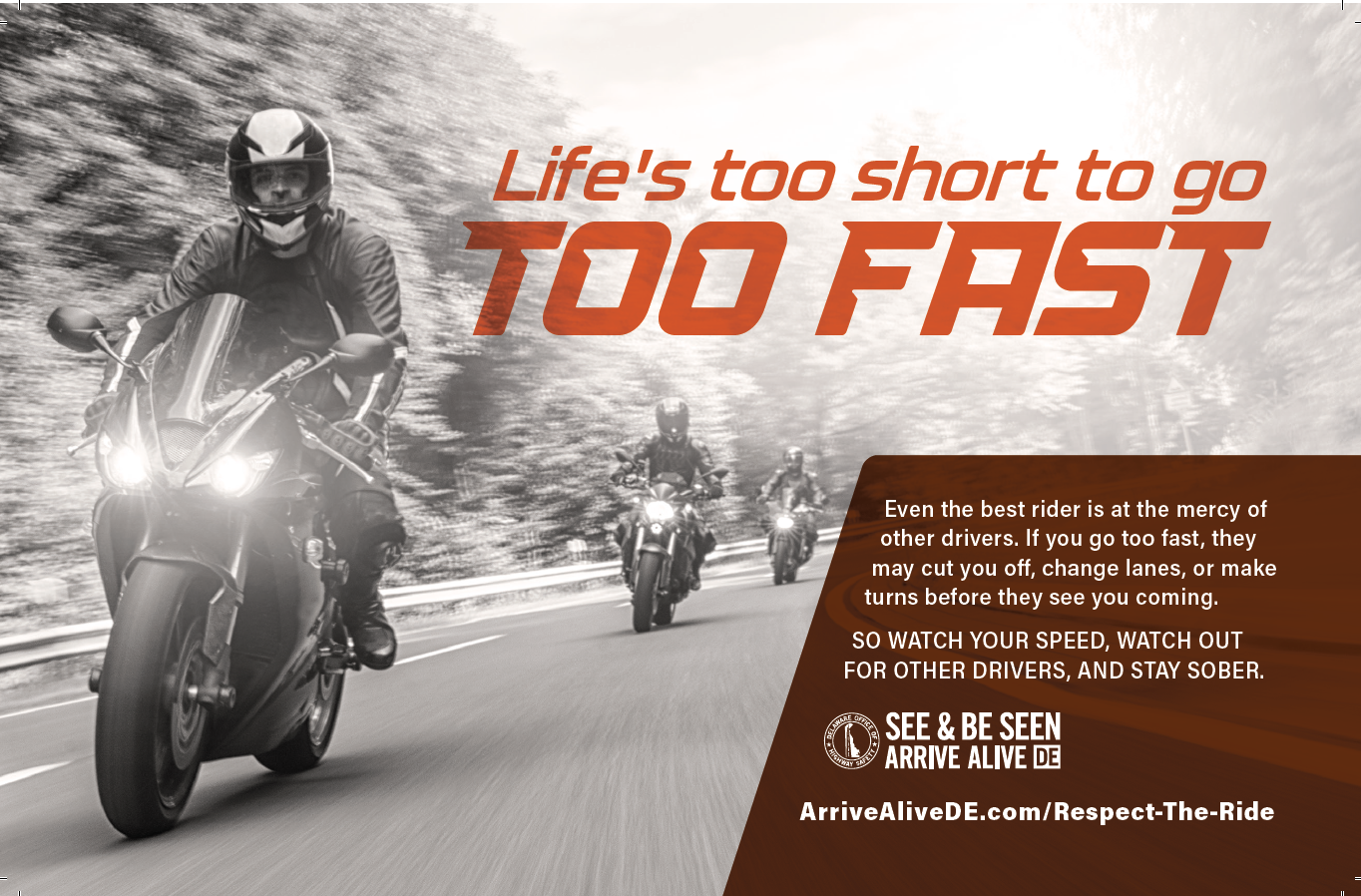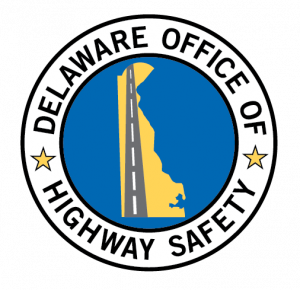Delaware Office of Highway Safety (OHS) Kicks Off Motorcyclist Safety Awareness Month
News | Date Posted: Tuesday, April 25, 2023
News | Date Posted: Tuesday, April 25, 2023

DOVER, Del. (April 25, 2023) — The Delaware Office of Highway Safety (OHS) kicks off the riding season with its motorcyclist safety awareness campaign from 4/29 – 5/7 in conjunction with the Governor’s Proclamation designating May as Motorcyclist Awareness Month. OHS will be partnering with state and local law enforcement agencies to conduct statewide safety patrols to ensure motorcyclists and motorists are obeying traffic safety laws. Additionally, OHS is utilizing digital advertising, social media, public relations, and grassroots outreach to urge drivers and motorcyclists to share the road and be alert!
“In 2022 there were 22 motorcycle fatalities in Delaware. That is only 2 less than the 24 fatalities that happened in 2021. These numbers are continuing to trend the highest Delaware has seen in over 40 years. “Said Jackie McDermott, Traffic Safety Program Manager, Delaware Office of Highway Safety, “We want to remind motorcyclists to make themselves visible, follow posted speed limits, use DOT-compliant motorcycle helmets and safety gear, and always ride sober. OHS wants to remind motorists that all road users have the right to be safe using Delaware roadways and motorcyclists along with pedestrians and bicyclists deserve safety and protection while on the road.”
One of the primary contributing factors to motorcycle fatalities is speeding. In 2022, there were 234 motorcycle crashes and 76 serious injuries on Delaware roadways. Another primary factor in motorcycle crashes is motorists turning left into the path of a motorcyclist. Motorcycle riders aged 29 and under accounted for 45% of all fatalities, with most crashes occurring between 7:00 p.m. and 12:00 a.m. Alcohol impairment also plays a significant role in motorcycle-involved crashes accounting for 22% of these fatalities.
NHTSA reports that nationally in 2020, there were 5,579 motorcyclists killed in traffic crashes, an increase from 2019 (5,044). In contrast, an estimated 82,528 motorcyclists were injured, a 2% increase from 83,814 motorcyclists injured in 2019. Motorcyclist deaths accounted for 14% of the total highway fatalities that year.
Research also shows that motorcyclists are significantly overrepresented in traffic crashes and fatalities each year. In fact, in 2020, per vehicle mile traveled, motorcyclists were about 28 times more likely than passenger vehicle occupants to die in a motor vehicle crash and were 4 times more likely to be injured.
Motorcyclists have the same rights to the road, and the same desire to Arrive Alive. OHS is partnering with local motorcycle suppliers and dealerships to spread awareness of safe riding practices and encourage riders to sign up for a state-approved Motorcycle Rider Safety Course.
Safe driving and riding practices by all road users will help reduce the number of fatalities and injuries on our highways. While on the roadways keep the following tips in mind:
Tips for Riders
Tips for Motorists
For more information on the campaign, statistics, education on motorcycle safety, and to register for a motorcycle rider safety course visit https://www.arrivealivede.com/respect-the-ride/.

About the Delaware Office of Highway Safety
The Office of Highway Safety (OHS) is committed to improving the safety of Delaware’s motoring public by focusing on behavioral traffic safety issues, such as impaired driving, seat belt use, speeding, child passenger safety, pedestrian and bicycle safety, motorcycle safety, and teen driving issues. FAQs can be found at ArriveAliveDE.com. Follow OHS on the Delaware Office of Highway Safety website, Facebook, Twitter, Instagram, and TikTok.
Media Contact:
Delaware Office Of Highway Safety
Jason Coleman
jason.coleman@delaware.gov
302-744-2743 (office)
302-943-7293 (cell)
Meghan Niddrie
Meghan.niddrie@delaware.gov
302-744-2517 (office)
Keep up to date by receiving a daily digest email, around noon, of current news release posts from state agencies on news.delaware.gov.
Here you can subscribe to future news updates.
News | Date Posted: Tuesday, April 25, 2023

DOVER, Del. (April 25, 2023) — The Delaware Office of Highway Safety (OHS) kicks off the riding season with its motorcyclist safety awareness campaign from 4/29 – 5/7 in conjunction with the Governor’s Proclamation designating May as Motorcyclist Awareness Month. OHS will be partnering with state and local law enforcement agencies to conduct statewide safety patrols to ensure motorcyclists and motorists are obeying traffic safety laws. Additionally, OHS is utilizing digital advertising, social media, public relations, and grassroots outreach to urge drivers and motorcyclists to share the road and be alert!
“In 2022 there were 22 motorcycle fatalities in Delaware. That is only 2 less than the 24 fatalities that happened in 2021. These numbers are continuing to trend the highest Delaware has seen in over 40 years. “Said Jackie McDermott, Traffic Safety Program Manager, Delaware Office of Highway Safety, “We want to remind motorcyclists to make themselves visible, follow posted speed limits, use DOT-compliant motorcycle helmets and safety gear, and always ride sober. OHS wants to remind motorists that all road users have the right to be safe using Delaware roadways and motorcyclists along with pedestrians and bicyclists deserve safety and protection while on the road.”
One of the primary contributing factors to motorcycle fatalities is speeding. In 2022, there were 234 motorcycle crashes and 76 serious injuries on Delaware roadways. Another primary factor in motorcycle crashes is motorists turning left into the path of a motorcyclist. Motorcycle riders aged 29 and under accounted for 45% of all fatalities, with most crashes occurring between 7:00 p.m. and 12:00 a.m. Alcohol impairment also plays a significant role in motorcycle-involved crashes accounting for 22% of these fatalities.
NHTSA reports that nationally in 2020, there were 5,579 motorcyclists killed in traffic crashes, an increase from 2019 (5,044). In contrast, an estimated 82,528 motorcyclists were injured, a 2% increase from 83,814 motorcyclists injured in 2019. Motorcyclist deaths accounted for 14% of the total highway fatalities that year.
Research also shows that motorcyclists are significantly overrepresented in traffic crashes and fatalities each year. In fact, in 2020, per vehicle mile traveled, motorcyclists were about 28 times more likely than passenger vehicle occupants to die in a motor vehicle crash and were 4 times more likely to be injured.
Motorcyclists have the same rights to the road, and the same desire to Arrive Alive. OHS is partnering with local motorcycle suppliers and dealerships to spread awareness of safe riding practices and encourage riders to sign up for a state-approved Motorcycle Rider Safety Course.
Safe driving and riding practices by all road users will help reduce the number of fatalities and injuries on our highways. While on the roadways keep the following tips in mind:
Tips for Riders
Tips for Motorists
For more information on the campaign, statistics, education on motorcycle safety, and to register for a motorcycle rider safety course visit https://www.arrivealivede.com/respect-the-ride/.

About the Delaware Office of Highway Safety
The Office of Highway Safety (OHS) is committed to improving the safety of Delaware’s motoring public by focusing on behavioral traffic safety issues, such as impaired driving, seat belt use, speeding, child passenger safety, pedestrian and bicycle safety, motorcycle safety, and teen driving issues. FAQs can be found at ArriveAliveDE.com. Follow OHS on the Delaware Office of Highway Safety website, Facebook, Twitter, Instagram, and TikTok.
Media Contact:
Delaware Office Of Highway Safety
Jason Coleman
jason.coleman@delaware.gov
302-744-2743 (office)
302-943-7293 (cell)
Meghan Niddrie
Meghan.niddrie@delaware.gov
302-744-2517 (office)
Keep up to date by receiving a daily digest email, around noon, of current news release posts from state agencies on news.delaware.gov.
Here you can subscribe to future news updates.